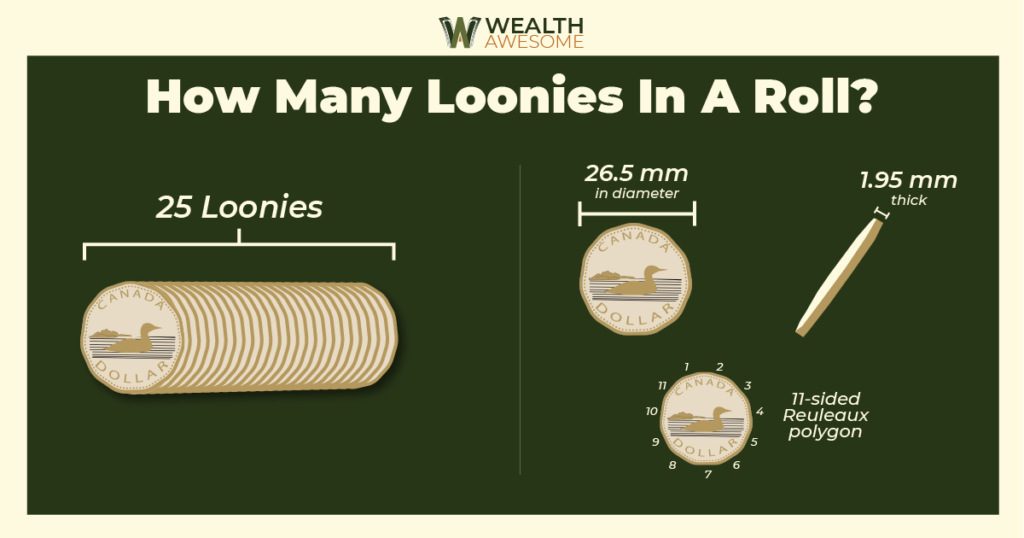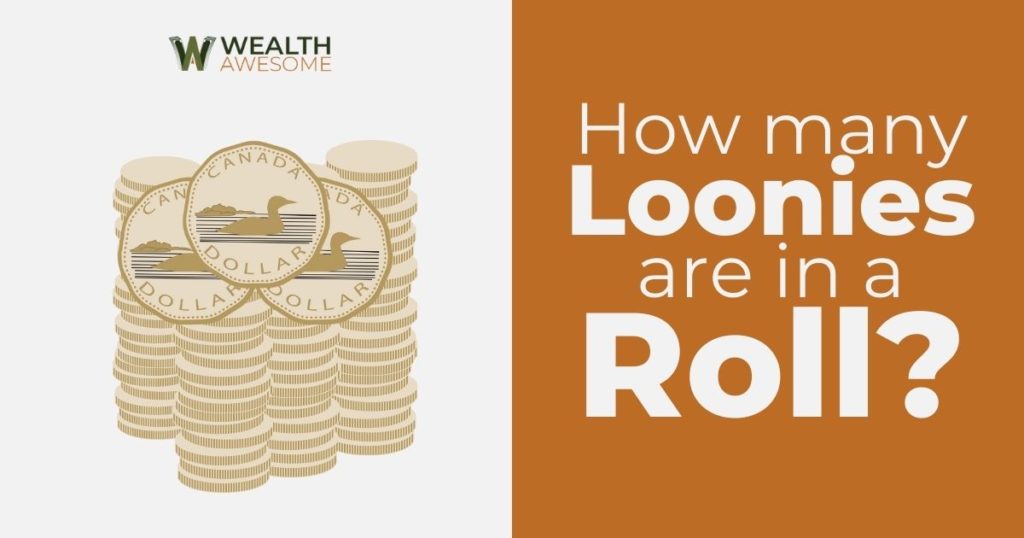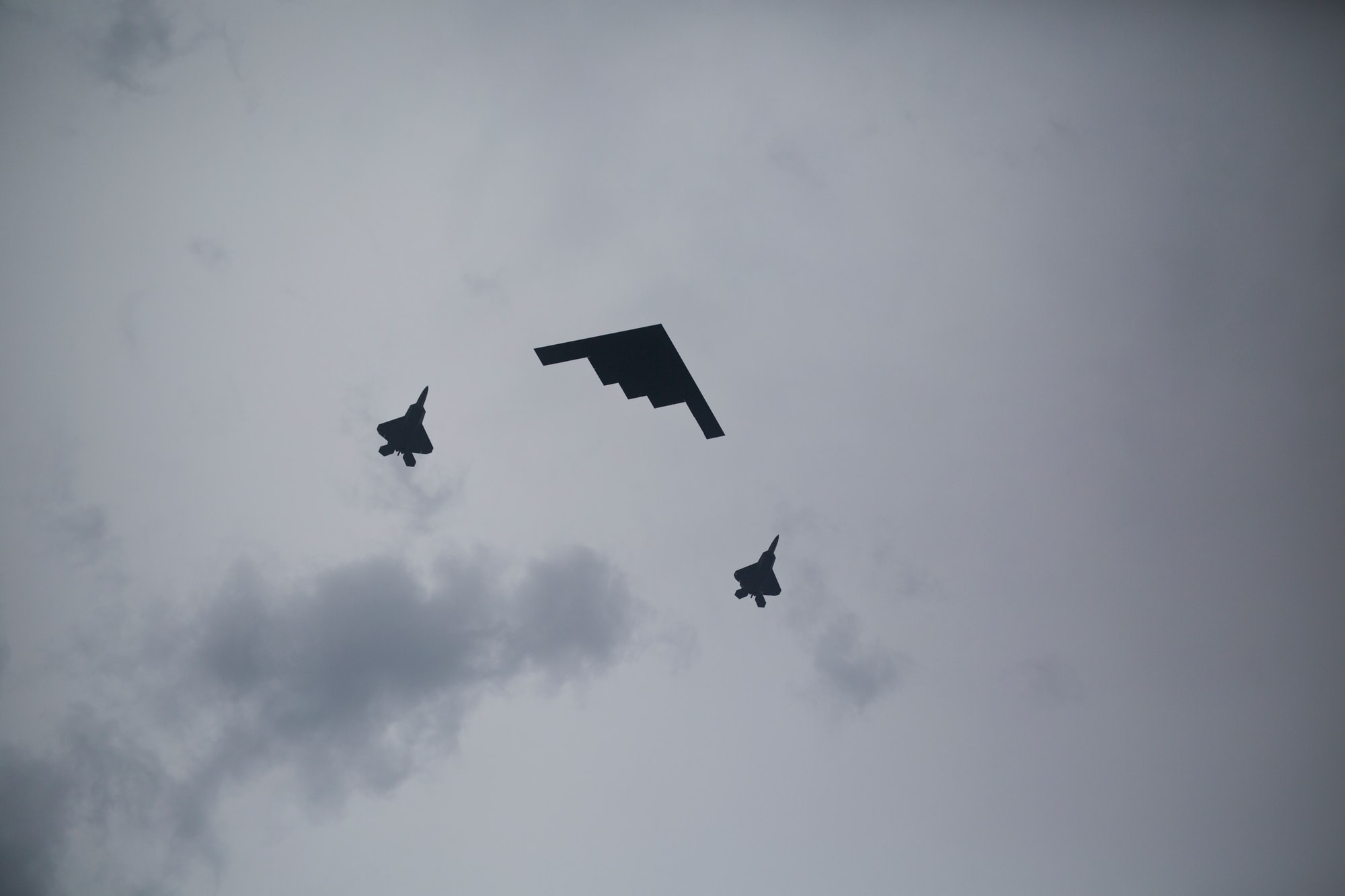Like maple syrup, hockey, and poutine, the golden loonie is an iconic symbol of Canada that many love.
Despite the rise of digital coins like Bitcoin, the loonie isn’t going anywhere. Like rolling up the rim of Tim Hortons cups, people will continue to roll loonies up for decades to come.
Many people think the answer to how many loonies are in a roll is 20, but they are sadly mistaken!
How Many Loonies Are in a Roll in Canada?

There are 25 loonies in a roll, which is equal to $25 in Canadian dollars (CAD).
In Canada, a standard roll of loonies contains 25 coins, amounting to a total value of $25 Canadian dollars (CAD).
These rolls are widely used for convenient storage and transportation of the one-dollar Canadian coin, commonly known as the “loonie” due to the iconic loon image depicted on its reverse side.
If you’re looking to exchange, store, or collect loonies, it’s important to know this roll denomination, as it plays a significant role in day-to-day transactions and commerce throughout the country.
Remember that Canadian coin rolls can be obtained for free from most banks or financial institutions, making them easily accessible to anyone in need.
The $1 Canadian coin, a.k.a. the loonie, gets its name from the picture of the loon found on the back side of the $1 coin, while Queen Elizabeth II adorns the front. The coin has been in circulation since 1987 as a cost-saving measure.
Note that there have been several versions of the $1 coin, including novelty and commemorative editions. However, the most common and prevalent version of the loonie has a solitary loon.
Loonie – Material and Dimensions
A loonie used to be made up of nickel and bronze, but the composition has changed over the years. Nowadays, the loonie is composed of steel with brass plating. It’s not a circular coin but an 11-sided Reuleaux polygon, making it circular-ish.
It’s 26.5 mm in diameter and 1.95 mm thick, and while these numbers might not matter right now, wait until you try and fit 25 loonies in a roll that was made for a different coin.
- Related Reading: 21 Proven Ways To Get Free Money In Canada

Canadian Coin Rolls – All Coins Currently Under Circulation
Canada stopped minting pennies in May 2012, and they are slowly being phased out of circulation, though they are still legal tender.
| Coin/Denomination | Coins per Roll | Cost of Roll | Diameter Of the Coin (mm) | Thickness Of the Coin (mm) |
|---|---|---|---|---|
| Loonie ($1) | 25 | $25 | 26.5 | 1.95 |
| Toonie ($2) | 25 | $50 | 28 | 1.75 |
| Five Cent/Nickel ($0.05) | 40 | $2 | 21.2 | 1.76 |
| Ten Cent/Dime ($0.1) | 50 | $5 | 18 | 1.22 |
| 25 Cent/Quarter ($0.25) | 40 | $10 | 23.88 | 1.58 |
This chart can help you realize that unless it’s a flexible or simple polythene roll, one roll for one coin cannot be used for the other because of different diameters.
How and Where to Buy or Cash in Your Canadian Coin Rolls?

If you have been saving loonies, toonies, and other coins in a jar and want to cash them in, you’ll have to find venues that will accept them. If you want to exchange cash for a roll of loonies because you need them for laundry, you might be looking for a place that offers this service.
Banks and Credit Unions
Whether you want to buy or cash in loonies, you should first try the bank or credit union you have an account with. They usually have pre-made rolls they can give you in exchange, though there might be a limit on how many rolls they can give you in a day, week, or month. If you are cashing in your loonies, you can roll the correct number in transparent plastic.
Coin counting machines
Some supermarkets and other stores in Canada may have coin-counting machines that accept loonies. These machines usually provide a voucher that can be used in the store or redeemed for cash at the customer service desk. I’ve seen some around at places like Safeway and Sobey’s and some bank branches at BMO. But beware, most of these machines will take a fee for this service, usually as a percentage of your total amount cashed.
Spend it
You can simply spend your loonies in stores, restaurants, and other businesses throughout Canada. Also, you can think of things like laundromats, arcades, and vending machines that usually accept loonies.
- Related Reading: 105 Clever Tips To Save More Money
Why Are Coins Put In A Roll?
Coin rolls are used to help organize large amounts of coins. Each denomination of coin roll contains a specific number of coins.
For example, a roll of loonies contains 25 coins and is worth $25.00.
The paper roll used to make a roll of coins is standardized by the Mint so that only a specific number of coins can fit within it. This is why you’ll never receive a roll of loonies with 25 or 30 coins in it.
This standardization ensures that the total face value for the coins in each roll is consistent and easily recognizable. This, in turn, helps bank tellers, customers, and small business owners easily keep track of their coins.
For example, when a store manager is counting their register, they can see a roll of loonies and automatically know that it’s worth $25 instead of having to manually count each coin.
Coin Collecting In Canada
Collecting loonies (and other coins) has become a popular hobby for many Canadians since we’re one of the few Western countries that regularly use coins for denominations over $1.
If you ask coin collectors why they picked up the hobby, you’ll likely get a number of different answers.
Some got into it because of a friend or family member. Others started by collecting loonies with their birth year on them. Some simply enjoy the history and art of coin-making and make it a point to research rare and valuable coins.
Certain mint dates are highly sought after by collectors due to changing coin properties and designs. As a general rule, old coins that are still in mint condition tend to be quite valuable.
Aside from standard coins, though, the Royal Canadian Mint also promotes coin collecting with its special limited edition coin releases. It often releases special edition coins to mark significant events, historical milestones, or celebrations.
The mint sells these coins in a special collectors’ case, and many of these have the potential to increase in value over time, similar to collecting sports cards.
Some notable commemorative loonies include:
- 1987 Introduction of the Loonie (the first loonie)
- The Royal Visit Coin
- 1967 Canadian Silver Dollar
- 150th Anniversary of Canada
- Newfoundland’s Accession to Canada
- 75th Anniversary of Signing the United Nations Charter
- Oscar Peterson Coin
- The Olympic “Lucky Loonie”
- 125th Anniversary of the Klondike Gold Rush
Loonies aren’t the only special-release coins, either. $2 “toonies” are also used for limited edition collectors’ coins.
For example, at the time of writing, the Royal Canadian Mint is offering a special 2023 toonie commemorating Indigenous Peoples Day. This unique coin features additional colours, including green, white, red, and orange, making it a standout coin for any collection.
The design of the coin incorporates art from Megan Currie (English River First Nation), Myrna Pokiak (Inuvialuit Settlement Region), and Jennine Krauchi (Red River Métis).
This $2 toonie is being sold for $18.88 by the Mint, and each coin comes with a commemorative notecard with words from the artists about their art and Indigenous Peoples Day.
Collectors seek out these special editions, and they can often be found for sale on various online platforms after the Mint has stopped production of them. The value of these coins can vary based on rarity, condition, and historical significance.
FAQs & Fun Facts About Canadian Coin Rolls
Now that you know how many loonies are in a roll, here are some other fun facts about Canadian coin rolls and other coins, including where to find special edition loonies.
Who Manufactures Canadian Coins?
All coins are manufactured by the Royal Canadian Mint. From nickels to quarters, loonies, and toonies, they’re all cut, pressed, and added to Canada’s coin circulation in the mint.
The Royal Canadian Mint is located in Winnipeg, Manitoba. This high-tech facility is one of the top-rated mints in the world. There’s also a historic mint located in Ottawa, where all special edition Canadian collector’s coins are manufactured.
The Royal Canadian Mint doesn’t just produce coins, either. The Winnipeg mint has produced millions of coins for over a thousand different countries!
Visitors and tourists can request a 45-minute tour at either location.
What’s The Most Popular Coin In Canada?
Despite the popularity of loonies and toonies, the most-used coin in Canada is the 1-cent coin. Although you may not enjoy getting a handful of pennies back, they’re an essential denominator that allows Canadians to deal in exact change, so they’re not going away any time soon.
Canadian Coins vs. US Coins: What’s The Difference?
If you’ve ever crossed the border to visit the US, then you may have realized that US coins are quite similar to Canadian coins. Like us, Americans use pennies, nickels, dimes, and quarters. They even have $1 coins (although they aren’t commonly used in the US).
Canada actually based their coins on the American system. Since we’re close neighbours and business partners, it made sense to have common denominators that everybody could understand.
Interestingly, though, both US and Canadian “dollar” coins are based on the original Spanish peso. This was the first dollar coin in production and became so popular that the US and Canada replicated their own dollar coins.
How Did The “Loonie” Get Its Name?
If you grew up in Canada, then you’ve probably never thought about this. For most kids, loonies are a part of everyday life. If you recently moved to Canada, though, you may be wondering, “Why are they called loonies?”
Looking at the front of the Canadian dollar coin, you’ll see a duck sitting in water. In Canada, ducks are often referred to as “loons,” which is why they’re called loonies.
Why Is Queen Elizabeth On The Loonie?
The loonie (and all other coins, for that matter) all feature a pressed image of Queen Elizabeth II. Since the queen was 8 years old, her face has been imprinted on all Canadian coins.
This is because England’s Queen Elizabeth II still remains the head of state in Canada. Despite Canada declaring independence in 1982, it’s still a part of the British Commonwealth.
The Queen’s position and powers are largely symbolic, and she plays very little role in Canadian politics. However, she’s still honoured as a part of Canadian culture.
Here’s a master list of how many coins are in a roll for the nickel, dime, quarter, loonie and toonie.
What Are Loonies Made Of?
Historically, loonies have been made using bronze-plated nickel. The nickel is what gave them such a heavy weight.
In 2012, though, the Canadian government decided to transition and started producing steel loonies. The goal was to save Canadian taxpayers an estimated $16 million in minting fees (which are collected through taxes). Steel is a far cheaper and more durable material than nickel.
The transition wasn’t good for everybody, though. Vending machine manufacturers, in particular, got the short end of the stick. Vending manufacturers and other coin businesses spent an estimated $40 million reprogramming their machines to accept the new steel loonies.
Why Is There A Loon On Loonies?
Loons are one of the most common birds in Canada and are found throughout the country. When the government made the decision to swap $1 bills for $1 coins, the Royal Canadian Mint commissioned reputable wildlife artist Robert Ralph-Carmichael to create the loonie using the image of a loon.
Sadly, the artist passed away in July 2016, shortly after his 78th birthday.
When Did Loonies First Come Out?
The loonie made its debut in 1987 when the Canadian government decided to do away with their traditional $1 bill. This decision was made in an effort to save Canadian taxpayers money in minting fees.
Today, loonies are the primary dollar used in Canada. Although a few $1 bills are still in circulation, they’re quite rare. $1 Canadian bills are generally viewed as collector’s items these days.
Where Can You Buy Canadian Coin Rolls In Canada?
The easiest way to get a roll of loonies is to visit your local Canadian bank. Here, you’ll be able to exchange $25 for a roll of 25 loonies or $50 for a roll of 25 toonies.
Where Can You Buy Special Edition Canadian Coins?
In 2010 a 1-cent Canadian collector coin famously sold for $400,000. Periodically, the Ottawa Mint released gold and silver-plated loonies and toonies as special edition coins.
The best place to buy special edition or rare Canadian coins is through coin collector platforms like GovMint.com. eBay is also another great place to find deals on rare Canadian coins.
How Valuable Are Special Edition Loonies?
It all depends on how many were produced, what materials they were made of, and the condition they’re in. On average, newer special edition loonies (dubbed “lucky loonies”) cost around $2 to $5 each.
Conclusion
There are 25 loonies in a roll in Canada, which is worth $25 CAD.
After you save up enough, consider depositing them into an online bank to get the best interest rates.
Also, check out how many quarters, pennies, or nickels are in a roll.





